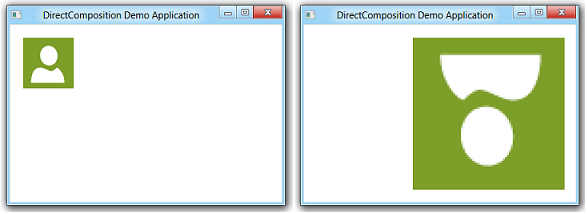2D 変換を適用する方法
注意
Windows 10上のアプリの場合は、DirectComposition ではなく Windows.UI.Composition API を使用することをお勧めします。 詳細については、「 Visual レイヤーを使用してデスクトップ アプリをモダン化する」を参照してください。
このトピックでは、Microsoft DirectComposition を使用して 2D 変換をビジュアルに適用する方法について説明します。 このトピックの例では、次の変換のグループを適用します。
- ビジュアルを 180 度回転させます。
- ビジュアルを元のサイズの 3 倍にスケールアップします。
- ビジュアルを元の位置の右側に 150 ピクセル移動 (移動) します。
次のスクリーン ショットは、2D 変換の適用前と適用後のビジュアルを示しています。

知っておくべきこと
テクノロジ
前提条件
- C/C++
- Microsoft Win32
- コンポーネント オブジェクト モデル (COM)
Instructions
手順 1: DirectComposition オブジェクトを初期化する
- デバイス オブジェクトとコンポジション ターゲット オブジェクトを作成します。
- ビジュアルを作成し、その内容を設定して、ビジュアル ツリーに追加します。
詳細については、「 DirectComposition を初期化する方法」を参照してください。
手順 2: 変換グループ配列を作成する
IDCompositionTransform *pTransforms[3];
手順 3: 変換オブジェクトを作成し、そのプロパティを設定し、それらを変換グループ配列に追加する
- IDCompositionDevice::CreateRotateTransform、::CreateScaleTransform、および ::CreateTranslateTransform メソッドを使用して、変換オブジェクトを作成します。
- IDCompositionRotateTransform、IDCompositionScaleTransform、および IDCompositionTranslateTransform インターフェイスのメンバー関数を使用して、変換のプロパティを設定します。
- 変換インターフェイス ポインターを変換グループ配列にコピーします。
IDCompositionRotateTransform *pRotateTransform = nullptr;
IDCompositionScaleTransform *pScaleTransform = nullptr;
IDCompositionTranslateTransform *pTranslateTransform = nullptr;
IDCompositionTransform *pTransformGroup = nullptr;
// Create the rotate transform.
hr = pDevice->CreateRotateTransform(&pRotateTransform);
if (SUCCEEDED(hr))
{
// Set the center of rotation to the center point of the visual.
hr = pRotateTransform->SetCenterX(BITMAP_WIDTH/2.0f);
if (SUCCEEDED(hr)) {
hr = pRotateTransform->SetCenterY(BITMAP_HEIGHT/2.0f);
}
// Set the rotate angle to 180 degrees.
if (SUCCEEDED(hr)) {
hr = pRotateTransform->SetAngle(180.0f);
}
// Add the rotate transform to the transform group array.
pTransforms[0] = pRotateTransform;
// Create the scale transform.
if (SUCCEEDED(hr)) {
hr = pDevice->CreateScaleTransform(&pScaleTransform);
}
}
if (SUCCEEDED(hr))
{
// Set the scaling origin to the upper-right corner of the visual.
hr = pScaleTransform->SetCenterX(0.0f);
if (SUCCEEDED(hr)) {
hr = pScaleTransform->SetCenterY(0.0f);
}
// Set the scaling factor to three for both the width and height.
if (SUCCEEDED(hr)) {
hr = pScaleTransform->SetScaleX(3.0f);
}
if (SUCCEEDED(hr)) {
hr = pScaleTransform->SetScaleY(3.0f);
}
// Add the scale transform to the transform group array.
pTransforms[1] = pScaleTransform;
// Create the translate transform.
if (SUCCEEDED(hr)) {
hr = pDevice->CreateTranslateTransform(&pTranslateTransform);
}
}
if (SUCCEEDED(hr))
{
// Move the visual 150 pixels to the right.
hr = pTranslateTransform->SetOffsetX(150.0f);
if (SUCCEEDED(hr)) {
hr = pTranslateTransform->SetOffsetY(0.0f);
}
// Add the translate transform to the transform group array.
pTransforms[2] = pTranslateTransform;
}
手順 4: 変換グループ オブジェクトを作成する
IDCompositionDevice::CreateTransformGroup メソッドを呼び出して、変換グループ オブジェクトを作成します。
if (SUCCEEDED(hr))
{
// Create the transform group.
hr = pDevice->CreateTransformGroup(pTransforms, 3, &pTransformGroup);
}
手順 5: 変換グループ オブジェクトをビジュアルに適用する
IDCompositionVisual::SetTransform メソッドを使用して、ビジュアルの Transform プロパティを変換グループ オブジェクトに関連付けます。
if (SUCCEEDED(hr))
{
// Apply the transform group to the visual.
hr = pVisual->SetTransform(pTransformGroup);
}
手順 6: コンポジションをコミットする
IDCompositionDevice::Commit メソッドを呼び出して、ビジュアルの更新を DirectComposition にコミットして処理します。 2D 変換のグループを適用した結果がターゲット ウィンドウに表示されます。
if (SUCCEEDED(hr))
{
// Commit the composition.
hr = pDevice->Commit();
}
手順 7: DirectComposition オブジェクトを解放する
必要なくなった 2D 変換オブジェクトのグループは、必ず解放してください。 次の例では、変換オブジェクトを解放するために、アプリケーション定義 の SafeRelease マクロを呼び出します。
// Release the transform objects.
for (int i = 0; i < 3; i++)
{
SafeRelease(&pTransforms[i]);
}
また、アプリケーションが終了する前に、デバイス オブジェクト、コンポジション ターゲット オブジェクト、ビジュアルも解放してください。
コード例全体
#define BITMAP_WIDTH 80.0
#define BITMAP_HEIGHT 80.0
HRESULT DemoApp::ApplyTransformGroup(IDCompositionDevice *pDevice,
IDCompositionVisual *pVisual)
{
HRESULT hr = S_OK;
if (pDevice == nullptr || pVisual == nullptr)
return E_INVALIDARG;
IDCompositionTransform *pTransforms[3];
IDCompositionRotateTransform *pRotateTransform = nullptr;
IDCompositionScaleTransform *pScaleTransform = nullptr;
IDCompositionTranslateTransform *pTranslateTransform = nullptr;
IDCompositionTransform *pTransformGroup = nullptr;
// Create the rotate transform.
hr = pDevice->CreateRotateTransform(&pRotateTransform);
if (SUCCEEDED(hr))
{
// Set the center of rotation to the center point of the visual.
hr = pRotateTransform->SetCenterX(BITMAP_WIDTH/2.0f);
if (SUCCEEDED(hr)) {
hr = pRotateTransform->SetCenterY(BITMAP_HEIGHT/2.0f);
}
// Set the rotate angle to 180 degrees.
if (SUCCEEDED(hr)) {
hr = pRotateTransform->SetAngle(180.0f);
}
// Add the rotate transform to the transform group array.
pTransforms[0] = pRotateTransform;
// Create the scale transform.
if (SUCCEEDED(hr)) {
hr = pDevice->CreateScaleTransform(&pScaleTransform);
}
}
if (SUCCEEDED(hr))
{
// Set the scaling origin to the upper-right corner of the visual.
hr = pScaleTransform->SetCenterX(0.0f);
if (SUCCEEDED(hr)) {
hr = pScaleTransform->SetCenterY(0.0f);
}
// Set the scaling factor to three for both the width and height.
if (SUCCEEDED(hr)) {
hr = pScaleTransform->SetScaleX(3.0f);
}
if (SUCCEEDED(hr)) {
hr = pScaleTransform->SetScaleY(3.0f);
}
// Add the scale transform to the transform group array.
pTransforms[1] = pScaleTransform;
// Create the translate transform.
if (SUCCEEDED(hr)) {
hr = pDevice->CreateTranslateTransform(&pTranslateTransform);
}
}
if (SUCCEEDED(hr))
{
// Move the visual 150 pixels to the right.
hr = pTranslateTransform->SetOffsetX(150.0f);
if (SUCCEEDED(hr)) {
hr = pTranslateTransform->SetOffsetY(0.0f);
}
// Add the translate transform to the transform group array.
pTransforms[2] = pTranslateTransform;
}
if (SUCCEEDED(hr))
{
// Create the transform group.
hr = pDevice->CreateTransformGroup(pTransforms, 3, &pTransformGroup);
}
if (SUCCEEDED(hr))
{
// Apply the transform group to the visual.
hr = pVisual->SetTransform(pTransformGroup);
}
if (SUCCEEDED(hr))
{
// Commit the composition.
hr = pDevice->Commit();
}
// Release the transform objects.
for (int i = 0; i < 3; i++)
{
SafeRelease(&pTransforms[i]);
}
// Release the transform group pointer.
SafeRelease(&pTransformGroup);
return hr;
}
関連トピック